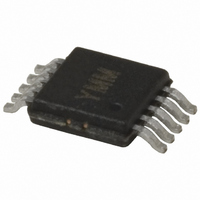MIC2204BMM Micrel Inc, MIC2204BMM Datasheet - Page 10

MIC2204BMM
Manufacturer Part Number
MIC2204BMM
Description
IC CONV SYNC BUCK PWM HE 10MSOP
Manufacturer
Micrel Inc
Type
Step-Down (Buck)r
Datasheet
1.MIC2204YML_TR.pdf
(11 pages)
Specifications of MIC2204BMM
Internal Switch(s)
Yes
Synchronous Rectifier
Yes
Number Of Outputs
1
Voltage - Output
Adj to 1V
Current - Output
600mA
Frequency - Switching
2MHz
Voltage - Input
2.3 ~ 5.5 V
Operating Temperature
-40°C ~ 125°C
Mounting Type
Surface Mount
Package / Case
10-MSOP, Micro10™, 10-uMAX, 10-uSOP
Lead Free Status / RoHS Status
Contains lead / RoHS non-compliant
Power - Output
-
Available stocks
Company
Part Number
Manufacturer
Quantity
Price
Company:
Part Number:
MIC2204BMM
Manufacturer:
MICREL
Quantity:
3 860
Company:
Part Number:
MIC2204BMM TR
Manufacturer:
MICREL
Quantity:
2 128
Company:
Part Number:
MIC2204BMM TR
Manufacturer:
MICREL
Quantity:
10 296
MIC2204
PWM Operation
The MIC2204 is a pulsewidth modulation (PWM) controller.
By controlling the ratio of on-to-off time, or duty cycle, a
regulated DC output voltage is achieved. As load or supply
voltage changes, so does the duty cycle to maintain a
constant output voltage. In cases where the input supply runs
into a dropout condition, the MIC2204 will run at 100% duty
cycle.
The MIC2204 provides constant switching at 2MHz with
synchronous internal MOSFETs. The internal MOSFETs
include a high-side P-Channel MOSFET from the input
supply to the switch pin and an N-Channel MOSFET from the
switch pin to ground. Since the low-side N-Channel MOSFET
provides the current during the off cycle, a free wheeling
Schottky diode from the switch node to ground is not required.
PWM control provides fixed frequency operation. By main-
taining a constant switching frequency, predictable funda-
mental and harmonic frequencies are achieved. Other meth-
ods of regulation, such as burst and skip modes, have
frequency spectrums that change with load and can interfere
with sensitive communication equipment.
M9999-042205
10
Synchronization
SYNC_IN allows the user to change the frequency from
2MHz up to 2.5MHz or down to 1.8MHz. This controls the
fundamental frequency and all the resultant harmonics. Main-
taining a predictable frequency creates the ability to either
shift the harmonics away from sensitive carrier and IF fre-
quency bands, or to accurately filter out specific harmonic
frequencies.
Connecting the SYNC_OUT function pin to the SYNC_IN of
other MIC2204s will synchronize multiple MIC2204s in a
daisy-chain. Synchronizing multiple MIC2204s means that
regulators will run at the same fundamental frequency, result-
ing in matched harmonic frequencies and simplifying design
for sensitive communication equipment.
Micrel, Inc.
April 2005













